6. GitHub Workflow
6.1. How METplus releases are created
The branching model employed by the METplus GitHub repository is similar to that described in A successful Git branching model, where new or updated code is created on a ‘feature’ branch that is based on the dtcenter/METplus GitHub ‘develop’ branch.
The feature branch is named after the corresponding GitHub issue:
feature_<Github Issue number>_<brief_description>
When work is complete, the code in the feature branch is merged into the develop branch. When a release candidate for METplus has been determined, then the develop branch is used to create a main_vx.y release of METplus, which includes data tarballs for use in running use cases.
6.2. GitHub Projects to manage development
Software development for official METplus releases is organized into development cycles. While the length a development cycle can vary widely, they are nominally 6 weeks long. GitHub issues and pull requests assigned to each cycle are either completed during the time window for that cycle or reassigned to a future development cycle.
Each development cycle culminates in the creation of a software release. The Stages of the METplus Release Cycle section describes the various types of software releases (development, official, or bugfix). Each development cycle culminates in a beta release, a release candidate, or the official release. Generally, a beta development cycle results in a beta development release while an rc development cycle results in an rc development release.
The METplus team uses GitHub projects to manage these development cycles as well as the support of official releases. In earlier versions, each development cycle was managed by an individual GitHub project but more recent versions use a single GitHub project to manage all of the development cycles. Listed below are instructions for creating a single GitHub project to manage development toward a new official release. Note that sufficient permissions in GitHub are required to perform the following steps.
Create a New project.
From the DTCenter GitHub Projects page, select the New project button.
In the Select a template popup window, select the Project templates: Feature option, and click the Create button.
Update the project Settings.
Click on the three dots to the right of the project name to see More options and select Settings. Modify these settings as follows.
Project name: The default project name is @UserNames’s feature. Rename it as {METplus Component}-{Target Version Number} Development (e.g. METplus-5.1.0 Development).
Add a description: Add Development toward {METplus Component} version {Target Version Number}.
README: Add additional details as needed to the README section. Projects managing development for multiple repositories, such as METplus-Analysis, should list the target version number for each repository.
Scroll down to the Danger zone and change Visibilty from its default value of Private to Public.
Select Manage access on the left hand navigation bar.
By default, the project creator has Admin access.
Add Admin access for any user with that level of access to any one of the repositories managed by this project.
Add Write access for the METplus group.
Locate the Custom fields section in the left hand navigation bar
Select Status and retain the default list of options, but delete the New option by clicking the X to its right.
Select Iteration and modify the Field name to be Cycle. Delete any existing cycles. Under More options select a Start on date and set the default Duration as 6 weeks. Click the Add and Add iteration buttons to create 5 cycles, each with the default duration of 6 weeks. Modify the cycle names to be Beta1, Beta2, and so on. Click Save changes.
Select Estimate and click the three dots to the right and Delete field.
Click the back arrow to return to the project page.
Update the project Workflows.
Click on the three dots to the right of the project name to see More options and select Workflows. Modify these settings as follows.
Enable the Item added to project workflow and set the status to Backlog.
Enable the Item reopened workflow and set the status to In progress.
Enable the Item closed workflow and set the status to Done.
Enable the Pull request merged workflow and set the status to Done.
Leave all other workflows disabled.
Click the back arrow to return to the project page.
Create project Views.
Each view appears as a tab on the project page. Create a new view as described below.
Select the + New view option.
Click on the view name to modify it, rename it as All Cycles, and hit Enter.
Click on the down arrow and, under Configuration, select the Fields option. Enable the options for Title, Repository, Assignees, Cycle, Status, Linked Pull Request, and Reviewers. Drag and drop the items to reorder them as listed above.
In the resulting view, click the three dots in the Status column. Select the Sort descending and Group by values options.
The blue dot on the down arrow for this tab indicates that there are unsaved changes. Select the Save changes option.
Click on the down arrow and select Duplicate View. Do this 8 times and name/refine these views as follows.
View name All Required shows all items labelled as REQUIRED for the development or official release. Click on the 3 horizontal bars and define the filtering criteria as
is:open label:'required: FOR OFFICIAL RELEASE','required: FOR DEVELOPMENT RELEASE'. Click Save Changes.View names Beta1 through Beta5 show items for each individual development cycle. Click on the 3 horizontal bars and define the filtering criteria as
cycle:Beta1,cycle:Beta2, and so on. Click Save Changes.View name Closed Issues shows issues that have been closed across all development cycles. Click on the 3 horizontal bars and define the filtering criteria as
is:closed is:issue. Click on the 3 dots in the Cycle column and select Group by values. Click Save Changes.View name High/Blocker Not Required shows all items labelled as HIGH or BLOCKER priority but not marked as required for the development or official release. Click on the 3 horizontal bars and define the filtering criteria as
is:open label:'priority: high','priority: blocker'-label:'required: FOR DEVELOPMENT RELEASE'-label:'required: FOR OFFICIAL RELEASE'. Click Save Changes.
Delete any other views created by default by clicking the down arrow next to the view name and selecting Delete view.
Refine the project settings, development cycle dates, and views, as needed, based on the preferences of the development team.
Link the new project to each repository.
Navigate to the project page for each repository managed by this project (e.g. METplus Projects).
Click the Link a project button and find/select this newly created project.
6.3. GitHub Projects to manage support
Support for coordinated METplus releases is managed using a single GitHub project for all components. Bugfix issues and the corresponding pull request fixes are added to that support project. Each fix is assigned to the current bugfix milestone of the corresponding source code repository.
The Stages of the METplus Release Cycle section describes the various types of software releases (development, official, or bugfix). The GitHub support project contains issues and pull requests that apply only to bugfix releases.
Listed below are instructions for creating a GitHub project to manage support after an official coordinated METplus release. Note that sufficient permissions in GitHub are required to perform the following steps.
Create a New project.
From the DTCenter GitHub Projects page, select the New project button.
In the Select a template popup window, select the Project templates: Feature option, and click the Create button.
Update the project Settings.
Click on the three dots to the right of the project name to see More options and select Settings. Modify these settings as follows.
Project name: The default project name is @UserNames’s feature. Rename it as METplus Version X.Y Support (e.g. METplus Version 5.0 Support).
Add a description: Add Issues related to support for the METplus X.Y coordinated release.
README: List the X.Y version number for each METplus component contained within the coordinated release.
Scroll down to the Danger zone and change Visibilty from its default value of Private to Public.
Select Manage access on the left hand navigation bar.
By default, the project creator has Admin access.
Add Admin access for at least 2 other users with that level of access on one of the METplus component repositories.
Add Write access for the METplus group.
Locate the Custom fields section in the left hand navigation bar
Select Status and retain the default list of options, but delete the New option by clicking the X to its right.
For Iteration and Estimate, click the 3 dots to the right of the Field name and Delete field.
Click the back arrow to return to the project page.
Update the project Workflows.
Click on the three dots to the right of the project name to see More options and select Workflows. Modify these settings as follows.
Enable the Item added to project workflow and set the status to Backlog.
Enable the Item reopened workflow and set the status to In progress.
Enable the Item closed workflow and set the status to Done.
Enable the Pull request merged workflow and set the status to Done.
Leave all other workflows disabled.
Click the back arrow to return to the project page.
Create project Views.
Each view appears as a tab on the project page. Create a new view as described below.
Select the + New view option.
Click on the view name to modify it, rename it as All Milestones, and hit Enter.
Click on the down arrow and, under Configuration, select the Fields option. Enable the options for Title, Repository, Assignees, Milestone, Status, Linked Pull Request, and Reviewers. Drag and drop the items to reorder them as listed above.
In the resulting view, click the three dots in the Milestone column. Select the Sort descending and Group by values options.
The blue dot on the down arrow for this tab indicates that there are unsaved changes. Select the Save changes option.
Click on the down arrow and select Duplicate View. Name/refine this views as follows.
View name Closed Issues shows issues that have been closed across all bugfix milestones. Click on the 3 horizontal bars and define the filtering criteria as
is:closed is:issue. Click on the 3 dots in the Milestone column and select Group by values. Click Save Changes.
Delete any other views created by default by clicking the down arrow next to the view name and selecting Delete view.
Refine the project settings and views, as needed, based on the preferences of the support team.
Link the new project to each repository.
Navigate to the project page for each METplus component repository:
Click the Link a project button and find/select this newly created support project.
6.4. Sequence of Events - Contributing Code
Prerequisite:
The user must set up a GitHub account if one does not already exist. Log into the account. For more information about GitHub accounts, please refer to the GitHub Documentation on GitHub accounts.
6.4.1. Workflow Overview
Contributors will follow these instructions for new development. Detailed instructions for each item can be found below or by clicking the link.
6.4.1.1. Find or Create a GitHub Issue
Go to the METplus repository and click on the Issues tab.
Search for an existing issue that describes the contribution. If one exists, take note of the issue number. If one cannot be found, create a new Discussion on the METplus GitHub Discussions page to ask if an issue should be created.
If creating a new issue, select the “New Issue” button and review the categories of issues (e.g. Bug report, enhancement request, New feature request, New use case, Sub-Issue, Task). Find an appropriate categories and click on “Get Started” next to the category.
Create a short, but descriptive title. In the ‘write’ window, follow the directions and fill in the template. Add any additional comments/details. When filling in the template, be sure to “Define the PR metadata, as permissions allow. Select: Assignee(s), Project(s), and Milestone”.
Before an issue is created, a “Project” can be selected, but there is no option to select a cycle.

After the issue is created, more options appear under the “Project” section.

Click the “Status” drop down and select “Todo”.

Click on “+1 more” then under “Cycle”, click “Choose an iteration” and select the current development cycle.

After selecting the appropriate “Cycle”, be sure to remove the alert: NEED CYCLE ASSIGNMENT label, which is added by default.
If the description of the issue is clear and does not need further definition, be sure to remove the alert: NEED MORE DEFINITION label, which is added by default.
6.4.1.2. Fork the dtcenter/METplus repository
If the contributor has write access to the dtcenter/METplus repository, then forking the repository is not necessary. If so, skip to the instructions related to creating a fork and keeping the fork in sync with the dtcenter/METplus repository.
Retrieve a copy of the source code by forking the dtcenter/METplus repository into the user’s own GitHub repository. Click on the Fork button in the upper right hand side of the METplus repository.
Verify that your GitHub username is shown in the Owner pull down menu. If it is not, then the forked repository likely already exists. If so, continue to Clone the repository locally.
Unselect the checkbox that says Copy the main_vX.Y branch only.
The web page will refresh to the GitHub repository. For example:
https://github.com/{github-username}/METplus
Where {github-username} is the user’s GitHub username. An entire copy of the dtcenter/METplus GitHub repository is now in the user’s area.
6.4.1.3. Clone the repository locally
Change directories to a working directory. From the command line, enter the following:
git clone https://github.com/{github-username}/METplus
replacing {github-username} with the user’s GitHub username. If not working from a fork, then use dtcenter.
Change directories to the METplus directory:
cd METplusThis is the local METplus repository.
6.4.1.4. Set upstream remote
If working from the dtcenter/METplus repository, skip this step.
Add a remote named origin to the clone of the local Git repository, which will allow changes to be pushed to the repository that was forked above.
git remote add upstream https://github.com/dtcenter/METplus
To verify that the upstream and origin are correct, at the command line enter:
git remote -vSomething like the following will be output:
origin https://github.com/{github-username}/METplus (fetch) origin https://github.com/{github-username}/METplus (push) upstream https://github.com/dtcenter/METplus (fetch) upstream https://github.com/dtcenter/METplus (push)
where {github-username} is the user’s GitHub username.
6.4.1.5. Create a feature branch
Generate a feature branch from the develop branch for new development following this naming convention:
feature_<Github Issue number>_<brief_description>
For example, for GitHub issue #777 that creates new wrapper xyz, the feature branch would be named:
feature_777_wrapper_xyz
Create the feature branch based off the develop branch:
git fetch upstream develop git checkout develop
Verify the current development branch is active by running:
git branchSomething like the following will be output:
* develop main_v4.1
The asterisk (*) indicates the active branch.
Ensure that the develop branch is in sync with the upstream develop branch:
git fetch upstream git merge upstream/develop git push origin develop
Create and checkout the feature branch. For example:
git checkout -b feature_777_wrapper_xyzreplacing feature_777_wrapper_xyz with the feature branch name.
Verify that the user is working in the correct branch by running:
git branchSomething like the following will be output:
develop main_v4.1 * feature_777_wrapper_xyz
The asterisk (*) indicates the active branch.
6.4.1.6. Make changes to code in the feature branch
Users should make changes to their feature branch and commit changes to their local repository.
If adding a new METplus use case:
Follow the instructions on the Adding Use Cases section of the Contributor’s Guide.
If making code changes:
Follow the coding standards in the Coding Standards section of the Contributor’s Guide.
Add unit tests using the pytest framework
Add documentation
If working in a forked repository, keep the fork in sync with the origin repository:
New changes to the origin repository may be added by others during development. Periodically apply these changes to the feature branch to avoid conflicts.
To merge the latest changes from the origin develop branch into the feature branch, run the following from the feature branch:
git fetch upstream git merge upstream/develop
The fetch command obtains all new changes from the upstream (dtcenter) repository. The merge command merges the latest changes from the upstream develop branch into the feature branch.
If not working in a forked repository, keep the feature branch in sync with the develop branch:
git fetch git merge develop
If the console output includes the text CONFLICT, then there are conflicts between the two branches that must be resolved manually. Refer to the GitHub documentation for help with Resolving a merge conflict using the command line.
6.4.1.7. Commit changes to feature branch
View all files that have changed since the last commit:
git statusIt is recommended to group related changes into a single commit. Mark files to be committed using the git add followed by the filename:
git add <filename1> git add <filename2>
Check the status again to verify that the correct files have been staged for commit:
git statusCommit the files by running the git commit command. The -m argument can be used to add a commit message to describe the changes.
git commitA popup window will appear. Enter a description about this commit, using the editor the user selected when the Git account was set up. Please refer to the Git Setup documentation on configuring a Git account.
For the first line of the commit comment, enter a brief description, such as the GitHub Issue number and a brief description. On the second and subsequent lines, provide a detailed description of the changes/additions that were made.
Note: It is a best practice to commit one change per commit, rather than wait until there are multiple changes to include in one commit.
Alternatively, the -m argument can be used to add a commit message to describe the changes.
git commit -m "{commit_message}"where {commit_message} is a descriptive message about the changes.
6.4.1.8. Push the feature branch to GitHub
Pushing changes up to GitHub periodically is recommended to avoid losing progress by relying on the local copy of the changes.
To push changes to GitHub, run the following:
git push origin <feature_777_wrapper_xyz>replacing <feature_777_wrapper_xyz> with the feature branch name
6.4.1.9. Open a pull request
To request to have the changes be incorporated into the remote repository (i.e. the GitHub METplus repository).
An authorized METplus developer will need to approve the request and then merge the files into the repository’s develop branch. The develop branch will be used to create a future METplus release.
If working from a fork, navigate to https://github.com/<github-user>/METplus where <github-user> is the user’s GitHub username. If working from a branch in the dtcenter organization, navigate to https://github.com/dtcenter/METplus
Click the ‘Pull Requests’ tab and click the green “New pull request” button.
If working from a fork, a web page with four grey buttons should appear:
On the left-most button (for setting the base repository), make sure the ‘base repository:dtcenter/METplus’ is selected.
For the base button, make sure to select ‘base:develop’.
For the head repository button, make sure to select ‘head repository:<your-github-user>/METplus’ with the appropriate replacement for <your-github-user>.
For the compare button, make sure to select ‘compare:<your_feature_branch>’ where <your_feature_branch> corresponds to the feature branch where the changes have been made (e.g. feature_777_wrapper_xyz).
If working from a branch in the dtcenter organization, there should be two grey buttons.
For the base button, select develop.
For the compare button, select the feature or bugfix branch.
In the ‘write’ window, follow the directions and fill in the template. Add any additional comments/details. When filling in the template, be sure to “Define the PR metadata, as permissions allow. Select: Reviewer(s), Project(s), and Milestone”. When selecting a reviewer, internal contributors submitting pull requests should select the appropriate reviewer(s) and let the reviewer know that the pull request has been assigned to them. If external contributors are unsure who to assign as a reviewer, create a post in the METplus GitHub Discussions Forum asking for help with the assignment of a reviewer.
When everything looks satisfactory, click on the green ‘Create pull request’ button.
Before a pull request is created, a “Project” can be selected, but there is no option to select a cycle.
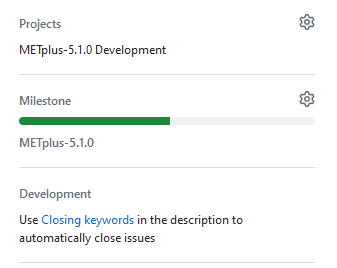
After the pull request is created, more options appear under the “Project” section.
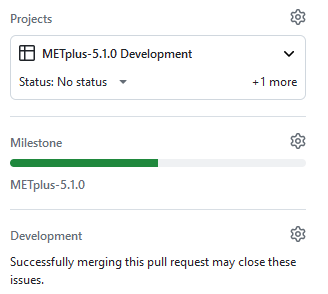
Click the “Status” drop down and select “Review”.
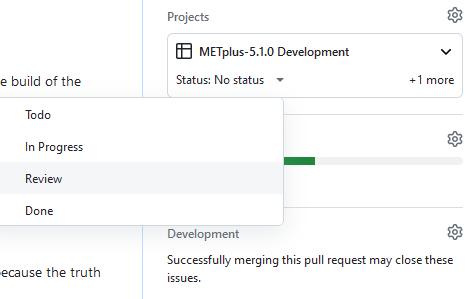
Click on “+1 more” then under “Cycle”, click “Choose an iteration” and select the current development cycle.
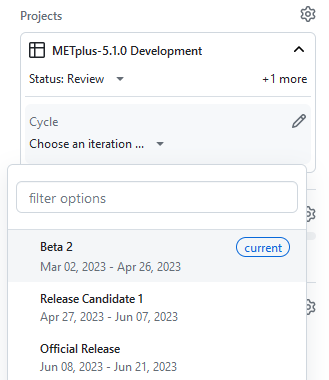
To link the issue that corresponds to the pull request, click on the gear next to “Development,” type the issue number, then select the issue that is displayed.
An authorized METplus developer will accept the pull request (if everything meets acceptance criteria) and merge the code into the remote repository’s develop branch.
6.4.2. Approve a pull request using a browser
Submitting a pull request allows a user to propose changes, request a review of the contributions and have the proposed changes merged into a different branch. Pull requests allow the reviewer to see the differences in the content from both branches.
For issues with sub-tasks, it may be desired to get some changes into the develop branch sooner, rather than later. If the changes seem to make sense on their own and don’t rely on other sub-tasks to be complete, creating a pull request for a sub-task may make sense. If a sub-task does rely on other sub-tasks to be complete, then it may be best to wait to create a pull request until the other sub-tasks are also complete.
6.4.2.1. Reviewing a pull request
Click on the “Pull requests” tab in the GitHub repository and click on the assigned pull request.
Ensure the continuous integration (CI) tests from GitHub Actions have passed. See “All checks have passed” in the figure below. If the tests were not successful or if there are conflicts with the base branch, ask the requestor to make changes.
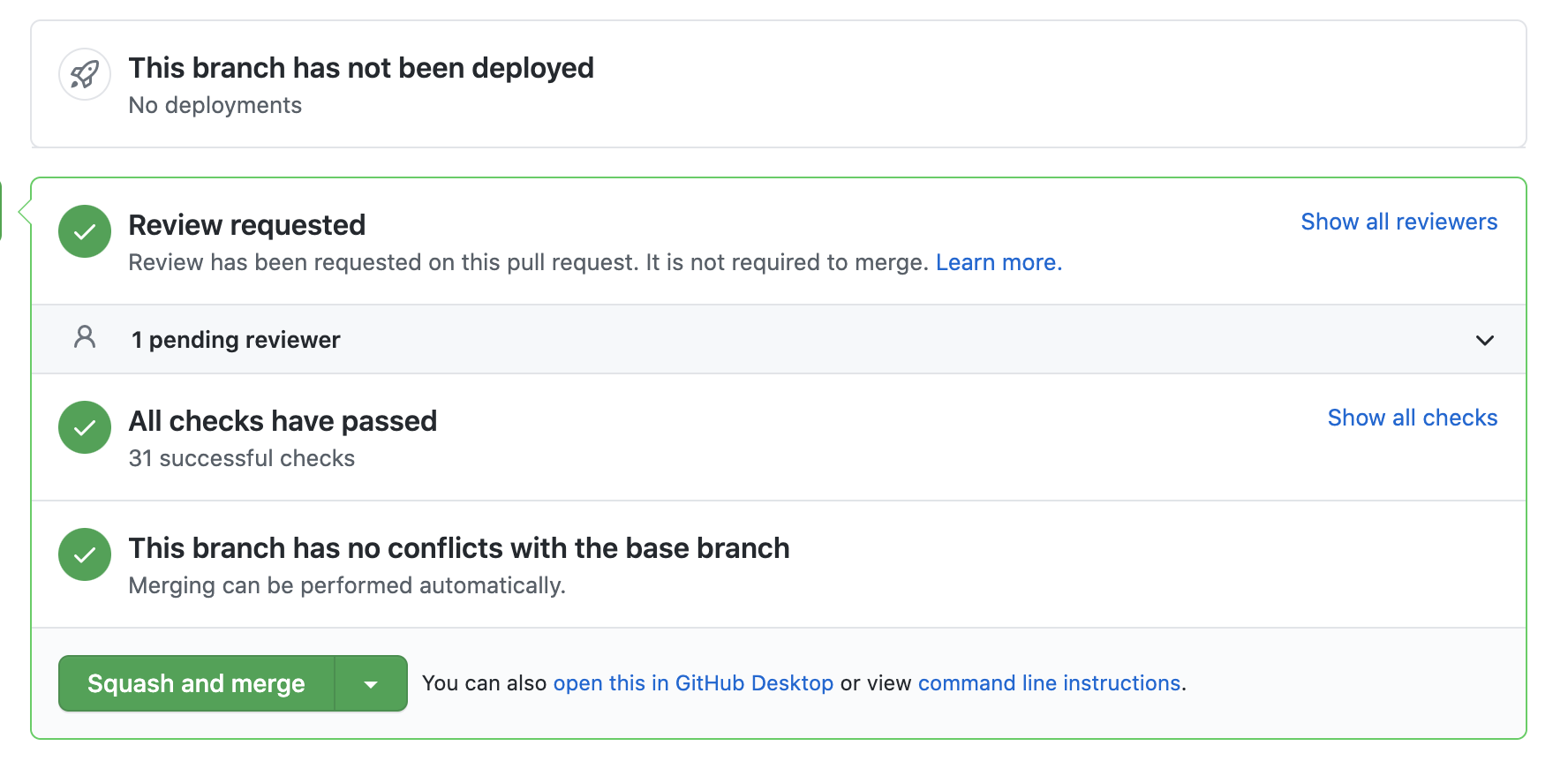
Take a look at the description of the testing already performed for these changes and then see what the recommended testing is for the reviewer to perform.
Perform any testing that is requested of the reviewer.
Check to ensure the correct “base” branch is selected. In most cases, the “base” branch will be the “develop” branch.
Click on the “Files Changed” tab to review the differences in code between the “base” branch and the “compare” branch.
Review each file and ensure that the changes seem reasonable.
A reviewer can suggest changes be made by:
Mousing over the line to comment on.

A blue box with a plus will appear. Click on the blue box.
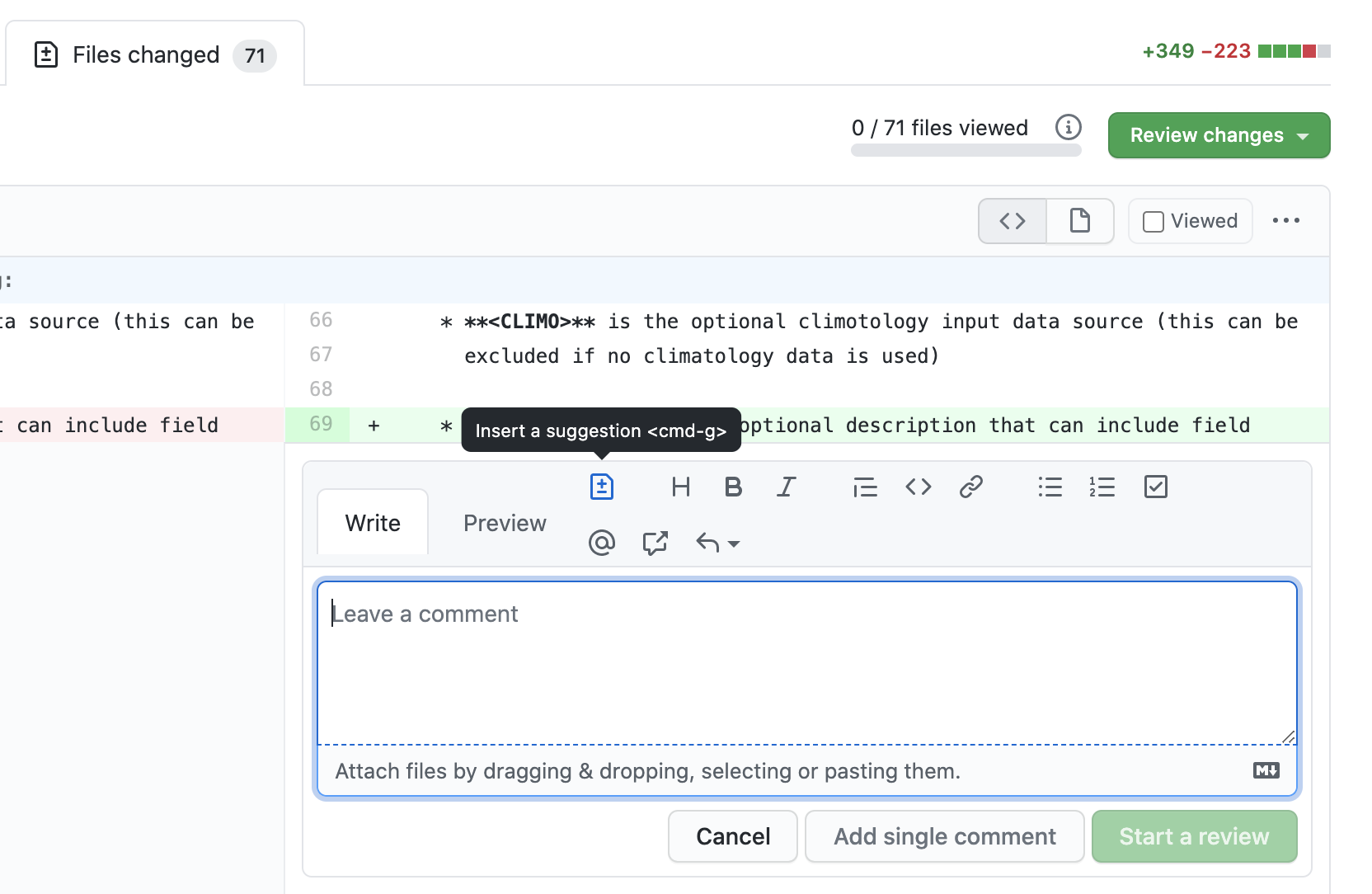
Click on the icon of a paper with +/- to “Insert a Suggestion”. The line will be quoted and the reviewer can enter their suggestion below. Then, click on the “Add Single Comment” button, so that the requestor will get an email letting them know the reviewer has made a suggested change.
Or, a reviewer can edit the file directly on the web by clicking on the “…” icon (three dots) in the right hand corner next to the “Viewed” icon and selecting “Edit file”.
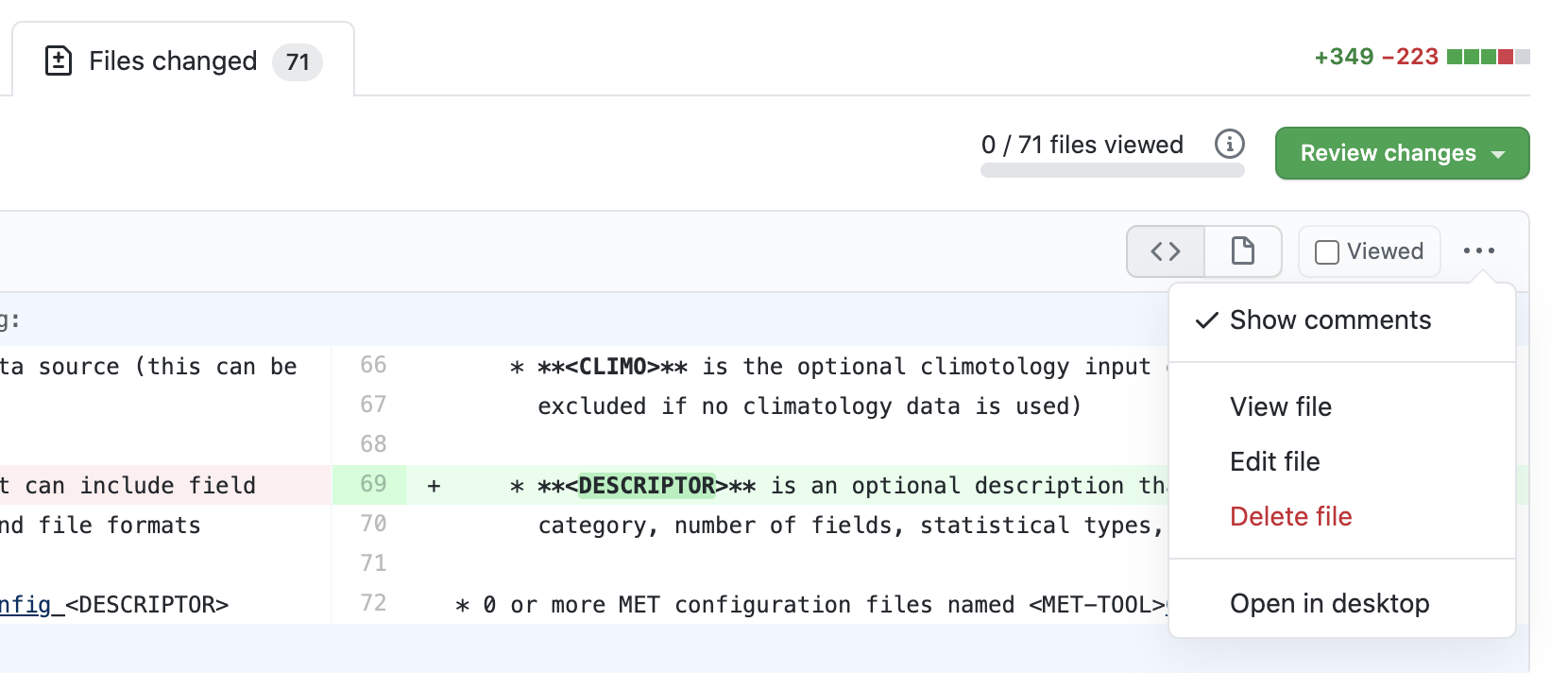
Ensure the requestor has made all necessary documentation updates.
Ensure the requestor has made all necessary testing updates.
If any changes were made, note that the CI tests will rerun. Before moving on, make sure “All checks have passed.” and make sure “This branch has no conflicts with the base branch”. Let the requestor know if the checks do not pass or if there is a conflict with the base branch so that they can make the necessary changes.
A reviewer has three possible options:
Comment: Submit general feedback without explicitly approving the changes or requesting additional changes.
Approve: Submit feedback and approve merging the changes proposed in the pull request.
Request changes: Submit feedback that must be addressed before the pull request can be merged.
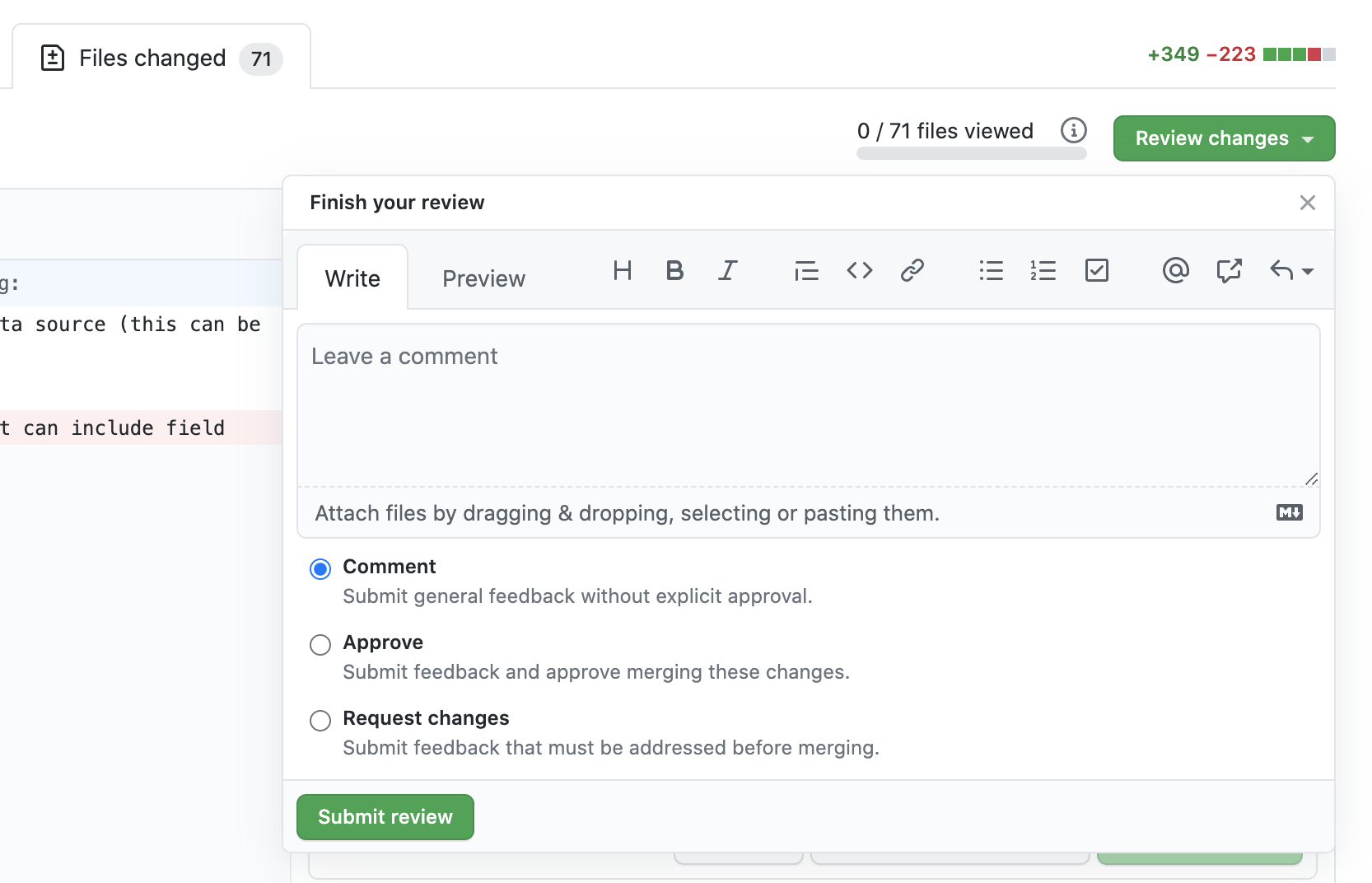
A reviewer should click on: “Review changes”, add comments to the “Write box”, and select either “Comment”, “Approve”, or “Request Changes”, and then click on “Submit Review”.
Once the recommended testing is complete and any necessary changes have been made, approve the request.
6.4.2.2. Merging pull requests
Once the pull request has been approved it is ready to be merged. As permissions allow, the requestor is responsible for merging the pull request once it has been approved.
There are three merge methods to choose from: “Create a merge commit”, “Squash and merge”, and “Rebase and merge”. It is recommended to use the Squash and merge method because all of the merge request’s commits are combined into one and a clean history is retained. Click on the chosen merge method.
After merging, the requestor can then decide whether or not to delete the branch.

If the requestor wishes to delete the “compare” branch, the “Delete branch” button should be selected and the corresponding GitHub issue should be closed.
6.4.2.3. Clean up after a successfully merged pull request
After an authorized METplus developer has accepted the changes and merged them into the develop repository, update the local clone by pulling changes from the original repository’s (i.e. the METplus develop branch):
Checkout the develop branch:
git checkout developVerify that the develop branch is now active:
git branchMerge changes from the upstream develop branch with the local develop branch:
git pull upstream developThe local cloned repository should now have all the latest changes from the original repository’s develop branch.
Now the feature branch can be deleted:
*git branch -D <branch name>* *git push --delete origin <branch name>*
where <branch name> is the feature branch name, e.g. feature_777_wrapper_xyz.
Verify that the feature branch has been successfully removed/deleted via the web browser. Navigate to https://github.com/<your-github-user>/METplus, replacing <your-github-user> appropriately. Under the ‘Branch’ pulldown menu, the feature branch name should no longer be seen as an option.